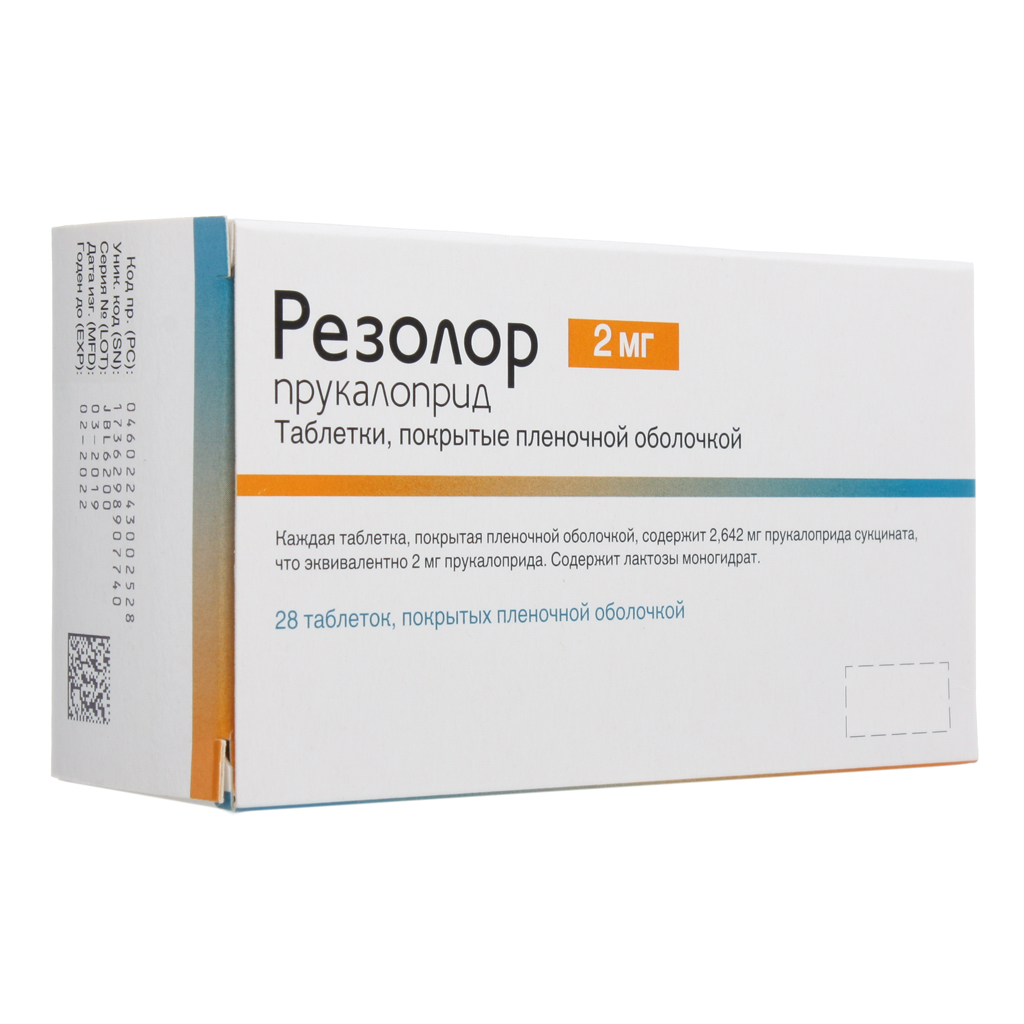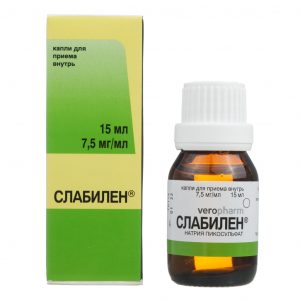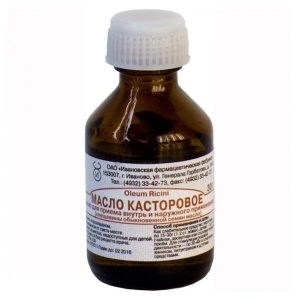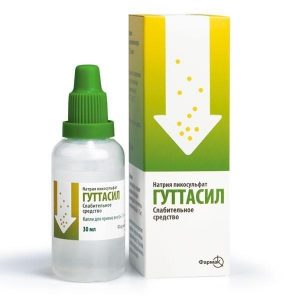Description
Latin name
RESOLOR
Release form
Film-coated tablets.
Packaging
In a blister pack of 7 tablets. There are 4 blisters in the package.
Indications
Resolor is intended for the symptomatic treatment of chronic constipation in women whose laxatives did not provide a sufficient effect in resolving the symptoms. The remedies did not provide a sufficient effect in eliminating the symptoms.
Contraindications
Hypersensitivity to the active ingredient or any adjuvant
impaired renal function requiring dialysis
perforation or bowel obstruction due to anatomical or functional disorders of the intestinal wall, mechanical intestinal obstruction, severe intestinal inflammation, for example Crohn’s disease, ulcerative colitis and toxic megacolon / megarectum
congenital lactase deficiency, lactose intolerance, glucose-galactose malabsorption.
Caution: the use of the drug in patients with severe and clinically unstable concomitant diseases (diseases of the liver, lungs, cardiovascular, neurological, endocrine diseases, mental disorders, oncological diseases, AIDS) has not been studied. Caution should be exercised when prescribing the drug Resolor to patients with such diseases. In particular, the drug should be used with caution in patients with a history of cardiac arrhythmia or coronary heart disease.
Pregnancy and lactation
Pregnancy
Experience with prucalopride during pregnancy is limited. In clinical studies, cases of miscarriage have been reported, although, given the presence of other risk factors, the relationship of these phenomena with the use of prucaloprid remains unproven. Animal studies have not revealed a direct or indirect adverse effect on the course of pregnancy, development of the embryo / fetus, childbirth and postnatal development of offspring. The drug Resolor is not recommended for use during pregnancy. During the period of treatment with prucaloprid, women capable of childbearing should use adequate methods of contraception.
Lactation
Prucaloprid is excreted in breast milk, however, when used in therapeutic doses, the drug is unlikely to affect newborns / infants. Due to the lack of data on the use in nursing mothers, the drug is not recommended for use during breastfeeding.
Ability to conceive
Animal studies have not revealed any effect of the drug on the fertility of males and females.
Composition
1 tablet contains:
Active substances: prucaloprid succinate 2.642 mg, which corresponds to the content of prucaloprid 2 mg.
Excipients: tablet core: lactose monohydrate – 165.458 mg, microcrystalline cellulose – 30 mg, colloidal silicon dioxide – 0.4 mg, magnesium stearate – 1.5 mg, pink film coating – 7 mg.
The composition of the pink film coating as a percentage by weight: hypromellose 6 cP – 40%, dye iron oxide red (E172) – 0.09%, titanium dioxide – 23.88%, macrogol 3000 – 8%, triacetin – 6%, lactose monohydrate – 22%, indigo carmine (E132) – 0.02%, yellow iron oxide dye (E172) – 0.01%.
Dosage and administration of
The drug is taken orally, regardless of food intake, at any time of the day.
Adults: 2 mg 1 time per day.
Elderly (over 65): start with 1 mg 1 time per day, if necessary, increase the dose to 2 mg 1 time per day.
Children and adolescents: Resolor is not recommended for use in children and adolescents under 18 years of age.
In patients with impaired renal function in severely impaired renal function (glomerular filtration rate less than 30 ml / min / 1.73 m), the dose is 1 mg 1 time per day. For patients with mild to moderate impaired renal function, dose adjustment is not required.
Patients with impaired liver function: in severely impaired liver function (Child-Pugh class C), the dose is 1 mg 1 time per day. For patients with mild to moderate impaired liver function, dose adjustment is not required.
Due to the specific mechanism of action of prucaloprid (stimulation of intestinal motility), an increase in the daily dose of more than 2 mg is unlikely to increase the effect. If taking prucalopride once a day for 4 weeks does not work, you should re-examine the patient and determine the appropriateness of continuing treatment.
Side effects
The most common adverse reactions with Resolor were headaches and adverse reactions from the gastrointestinal tract (abdominal pain, nausea, diarrhea), each of which was observed in about 20% of patients. Adverse reactions developed mainly at the beginning of treatment and usually disappeared after a few days, without requiring cancellation of treatment. Other adverse reactions have been observed occasionally. Most adverse reactions were mild or moderate.
At the recommended dose of 2 mg prucalopride, the following adverse reactions were recorded in clinical trials, the frequency of which is indicated as: very often (> 1/10)
often (> 1/100, <1/10) infrequently (> 1/1000, < 1/100) rare (> 1/10000, <1/1000) is very rare (<1/10000), including isolated cases. From the central nervous system: very often – headache often – dizziness infrequently – tremor. From the cardiovascular system: infrequently – palpitations. From the gastrointestinal tract: very often – nausea, diarrhea, abdominal pain often – vomiting, dyspepsia, rectal bleeding, flatulence, pathological intestinal noises infrequently – anorexia. From the genitourinary system: often – pollakiuria. General: often – weakness infrequently – fever, poor health. Drug Interaction In vitro data suggest a weak ability of prucalopride to interact, and at therapeutic concentrations it is unlikely to affect the metabolism of cytochrome enzymes administered concurrently. Although prucalopride can bind poorly to P-glycoprotein (P-GP), in clinically relevant concentrations it does not inhibit activity (P-GP). A potent inhibitor of CYP3A4 and P-glycoprotein ketoconazole at a dose of 200 mg 2 times a day increased the AUC (area under the concentration-time curve) of prucalopride by about 40%. This effect is too small to be clinically relevant, and is most likely related to the suppression of the active transport of prucalopride by P-glycoprotein in the kidneys. The same interaction as with ketoconazole, can be observed with other active inhibitors of P-glycoprotein, such as verapamil, cyclosporin A and quinidine. Prucalopride is also likely transported in the kidneys and other carriers. Theoretically, the suppression of the activity of all the carriers involved in the active secretion of prucalopride in the kidney (including P-glycoprotein) can increase its systemic effect by 75%. Studies involving healthy volunteers have shown no clinically relevant effect of prucalopride on the pharmacokinetics of warfarin, digoxin, ethyl alcohol, and paroxetine. With the concomitant use of prucalopride and erythromycin, the plasma concentration of the latter increases by 30%. The mechanism of this interaction is not completely clear, but the available data indicate that it is most likely is not the result of the direct action of prucalopride, but a consequence of the high variability of the pharmacokinetics of erythromycin itself. Probenecid, cimetidine, erythromycin and paroxetine did not affect the pharmacokinetics of prucalopride at therapeutic doses. The drug Resolor should be used with caution in conjunction with drugs capable of prolonging the QTc interval. Atropine-like substances can attenuate the effects of prucalopride mediated through HT4 receptors. No interaction with food was found. Overdose A study involving healthy volunteers showed that prucalopride was well tolerated when increasing the dose to 20 mg once daily (10 times the recommended therapeutic dose). Overdose can lead to symptoms caused by an increase in known side effects of the drug, including headache, nausea and diarrhea. There is no specific antidote for the drug Resolor. In case of overdose, symptomatic and supportive therapy should be performed if necessary. Large fluid loss from diarrhea or vomiting may require correction of electrolyte balance disorders. Storage conditions Store in the original packaging for protection against moisture, out of the reach of children, at a temperature not exceeding 25 ° C. The Expiration of is 3 years. Deystvuyuschee substances Prukalopryd Dispensing from pharmacy dpffafaf177 old foodstuffs17750647ffref from pharmacies Prescription dosage form dosage form tablets Janssen Pharmaceuticals N.V., Belgium




